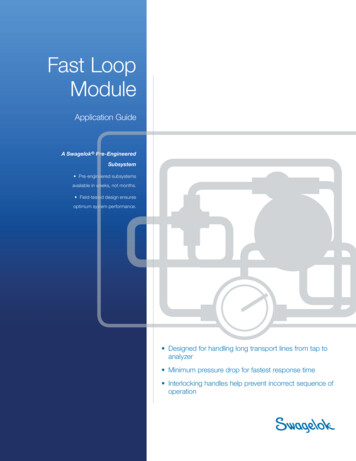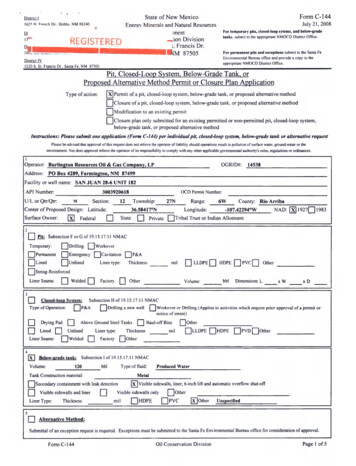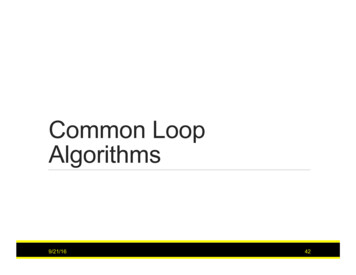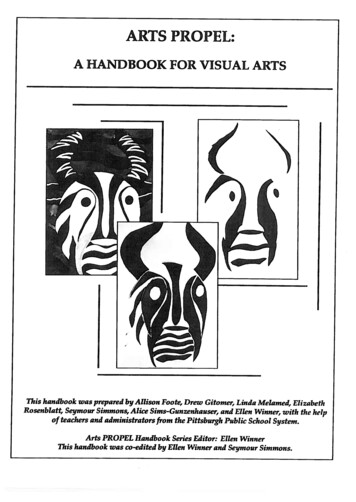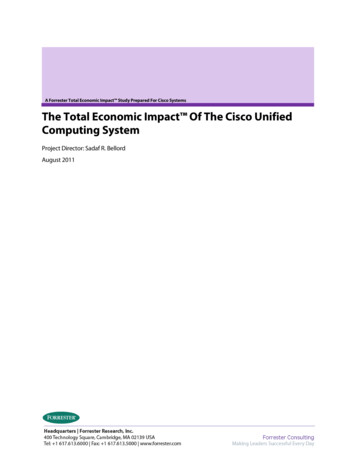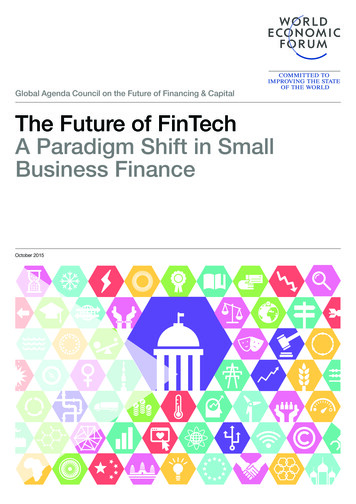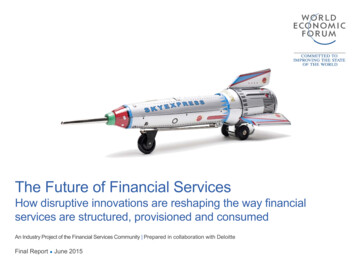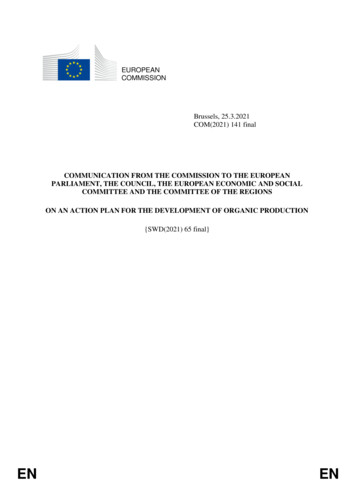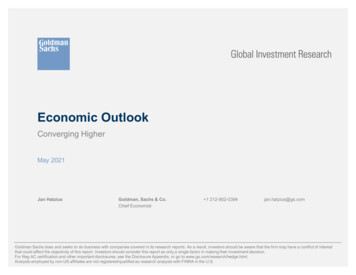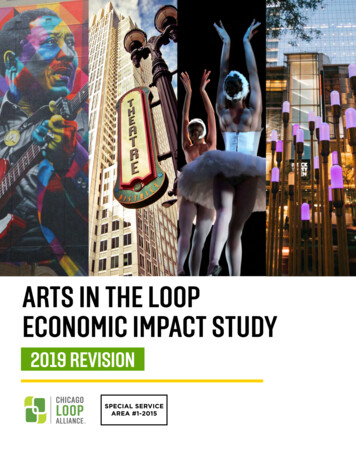
Transcription
ARTS IN THE LOOPECONOMICOP ARTSIN THEIMPACTLOOP STUDY2019REVISIONIMPACT STUDYACTECONOMICSTUDYLOOPCHICAGO.COMFront Cover Image Credits: Grant Wood. American Gothic (detail), 1930. The Art Institute of Chicago, Friends of American Art CollBack Cover Image Credits: Adam Alexander for Chicago Loop Alliance
STUDY BOUNDARY MAPA
DEAR FELLOW ARTS ADVOCATESOne year ago, Chicago Loop Alliance released its Arts in the Loop Economic Impact Study,sharing for the first time hard numbers on the impact the Loop’s arts and culture sector has onthe downtown, the city, and the state of Illinois. The findings—the sector’s annual impact of 2.25billion—have changed the way we are able to talk, fundraise, and advocate for the arts. I am thrilledto see the release of this new version of the report, featuring clarified and visualized explanations ofour data.As Chicago Loop Alliance’s immediate past board chair, I am so proud of this project. It is the dutyof a downtown management organization like ours to bring people together and share informationacross sectors. Because Chicago Loop Alliance undertook this report, the results were shared notonly with those in the arts community, but with those in real estate, retail, education, hospitality, andbeyond.In my role as Chief Development Officer for the Auditorium Theatre, I have used the Arts in the Loopreport to secure important corporate sponsorships and augment grant applications, providing crucialnumbers and evidencing the economic impact of the arts. In roles like mine, it is important to beable to talk hard numbers and actual impact. But beyond just the financial impact, it is also criticalto remember that the arts have an even broader reach. They bring people together and expand ourworldview. They create the kind of beautiful environment we all want to experience in Chicago. I’vespent my career talking about this side of the arts, the side that is harder to measure with numbersbut that is no less important. By talking about this broader impact that the arts can have, combinedwith the tangible numbers provided by this report, I am able to paint a fuller picture of why the artsmatter.Judie Moore GreenChief Development Officer, Auditorium TheatreChicago Loop Alliance Board MemberKEY FACTS ABOUT THE PERFORMING ARTS IN THE LOOP:11majorperforming artsvenues34,500 seats to viewperformances 90Mspent byvisitors ontickets andadmissions 233Mspent byperforming artsinstitutions onoperations5,934full timeequivalent jobsin the Loop
TABLE OFCONTENTSEXECUTIVE SUMMARY1STUDY PARTNERS & CREDIT10THE EVOLUTION OF ARTS IN THE LOOPTHE LOOP BELONGS TO EVERYONEYOUNG ARTISTS IN THE LOOP1719DETERMINING THE ECONOMIC IMPACTAPPENDIX30381121
INTRODUCTIONThis is a report commissioned by Chicago LoopAlliance, a downtown management organizationwith the mission to create, manage and promotehigh-performing urban experiences, attractingpeople and investment to the Loop. Togetherwith an engaged set of Loop arts organizations,a taskforce was formed to work with professionalconsultants ArtsMarket, Inc., and HR&A Advisorsto better understand the economic impact of thearts in the Loop.1 CHICAGO LOOP ALLIANCE
PURPOSEAs part of CLA’s efforts to promoteeconomic development andprovide services that benefitbusinesses, individuals andstakeholders within the Loop, CLAseeks to help its members gaina deeper understanding of theimpact the large collection of artsand cultural assets in the area haveon the Loop economy.The results of this study will beused to enhance the CLA brandand marketing narrative, providecase-making data to Loop artsand cultural organizations thatwill improve their position whenadvocating for public- and privatesector support and repositionarts and cultural organizationsas economic drivers in the Loopand the City of Chicago. Theinformation will also be usefulto other Chicago economicdevelopment organizations, likeChoose Chicago, World BusinessChicago and the City of ChicagoDepartment of Cultural Affairs andSpecial Events.ARTS IN THE LOOP ECONOMIC IMPACT STUDY 2
METHODOLOGYThe Joffrey Ballet credit-Cheryl MannThere are two primaryways to captureeconomic value. Thefirst is the expendituresof the institutions andorganizations beingstudied. The secondis the expenditure ofthe visitors to theseinstitutions, both onsite (admissions,refreshments) and offsite related to the visit.Off-site impacts includespending by visitors onhotels, restaurants, retailpurchases, transportationand more.To construct the modelfor the Arts in the Loopanalysis, this studydesign was based ondata reported by eachorganization using theIRS Form 990s as filedby all the nonprofitcultural organizations inthe Loop. Exact paralleldata was obtained fromgovernment and for-profitinstitutions.This data providedconsistent categoriesof institutional spending3 CHICAGO LOOP ALLIANCEdata along with visitationand employee countinformation.Visitor information inthis study was obtainedthrough an online surveyembedded on CLAand arts organizations’websites and widelypromoted. A total of12,161 surveys weresubmitted by Arts in theLoop visitors betweenOct. 15, 2017, and Jan.15, 2018. The surveyresponses were cleanedand standardized foranalysis, and multiplesurveys from the sameemail address wererejected.Initially, the researcherssought a responsepool of 4,145 to obtaina 2 percent margin oferror and a 95 percentconfidence rate. Sincethe actual response pooltotaled over 12,000, theresearchers were ableto use subsets of theresponses by geography,demographics andparticipation, with a highlevel of confidence.THREE AREASOF IMPACTDIRECTIMPACTThe actual spending of theLoop’s arts institutions – theirpayroll, the programs theyproduce and the related costsof operating their buildings.Direct impact of visitorsattending an event is thevisitor spending on the ticketfor the event.INDIRECTIMPACTSpending by the Loop’s artsinstitutions and arts visitors ongoods and services outsideof direct impact spending.For example, institutionalspending on advertising andmarketing or visitor spendingon a meal out fall underindirect impact.INDUCEDIMPACTThis is the economic benefitthat is created by both thedirect and indirect spendingcombined. For example, jobsin other industries supportedby spending related to theArts in the Loop represent aninduced impact.
UNIQUE DESIGNFew economic impacts of the artsstudies include data reflective ofall sectors of the arts in a region.This study has. Typically, for-profitarts presenters are left out, whichis a particular void in a city suchas Chicago in which Broadway inChicago serves an annual audienceof 1.6 million. Typically, arts economicimpact studies use as their informationsample audiences who completepaper surveys within venues theyare attending. This means there is noopportunity to capture informationfrom visitors who come into a city forthe experience of public art, enjoyinga park such as Millennium Park or whoexplore historic architecture.The Arts in the Loop study includesdata collection from the for-profit artsand their audiences and collectedvisitor information from those whodidn’t purchase tickets or attendticketed- or counted-admissionsevents.THIS STUDY ENCOMPASSES72 ARTS & CULTURAL INSTITUTIONSGEOGRAPHY OF STUDY AREAThe Loop, as defined for this study,extends to the Chicago River to thenorth; to the south branch of the ChicagoIda B WellsParkwayDriveRiver to the west; to Congressto the south; and to Lake Shore Drive tothe east. Included within this boundaryare Grant Park, Maggie Daley Park andMillennium Park.APPROXIMATELY 120 PUBLIC ART PIECESAND MORE THAN 50 ARCHITECTURALLYIMPORTANT BUILDINGS wITHIN THE LOOP,AMOUNTING TO A TOTAL OF APPROXIMATELY250 ARTS & CULTURAL ASSETS.ARTS IN THE LOOP ECONOMIC IMPACT STUDY 4
HISTORYCSO credit-Todd Rosenberg PhotographyThe Loop arts district had its genesisin the 1880s following the ChicagoFire of 1871. In 1887 the Art Instituteof Chicago opened its doors, andthe Auditorium Theatre opened twoyears later. By the end of the decadethe StudebakerStudebaker TheatreTheatre ––withinwithinthethetheFine ArtsArts BuildingBuilding ––hadhadopened.opened.FineOrchestra HallHall followedfollowed inin 1904,1904,Orchestraand byby thethe 1920s1920s scoresscores ofof theaterstheatersandopened, includingincluding thethe OrientalOriental (nowandopened,the an,withoftheCivicOperaHousecomingthe construction of the Civic Operatocompletionin 1929.Housecomingto completion in 1929.By the 1980s, many of these theatershad fallen into disrepair, and many hadevolved from live entertainment venuesto movie theaters. By the end of thedecade, the lights on those marqueeshad flickered out as well. But duringthis time, the Auditorium Theatrereceived a 13 million grant from theState of Illinois for interior upgrades.The Auditorium – together withOrchestra Hall and Lyric Opera House– was a consistently brightly-lit venueduring the 1990s when the nascentTheatre District was being planned.In the 1990s, the Loop Theatre Districtbecame its own destination,featuringmajor he(nowShubert(nowthe CIBC),Oriental and CadillacPalacetheatersNederlander)and CadillacPalace– all operatedby Broadwayin Chicagotheaters(all operatedby Broadwayin– and the andGoodmanTheatre Theatre,complex,Chicago)the Goodman5 5 CHICAGO LOOP ALLIANCECHICAGO LOOP ALLIANCEalong with the Gene Siskel Film Centerand the restored Chicago Theatre.In the Loop’s public art realm, agreat new era began with the 1967installation of the Picasso sculpture. In1978, Chicago became the largest cityin the United States – as well as one ofthe first – to pass a percent for publicart ordinance, making it possible tofund additional iconic public art.A major breakthrough in reshaping theLoop as an interconnected culturalzone came in 1998 when then-MayorRichard M. Daley announced a projectthat would later be named MillenniumPark, which opened in 2004 and whichextends Grant Park’s footprint northand includes such cultural gems asAnish Kapoor’s Cloud Gate (“TheBean”) and Jay Pritzker Pavilion.IN 1978, CHICAGO BECAME THE LARGEST CITY- AS wELL AS ONE OF THE FIRST - TO PASS APUBLIC ART ORDINANCEMAKING IT POSSIBLE TOFUND ADDITIONALICONIC PUBLIC ART.
Today, there are at least 250 culturalassets whose collective presencedefines the Loop. The Loop is hometo 11 major performing arts andtheatrical venues, 13 museums andgalleries, scores of performing andvisual arts organizations and one ofthe world’s most iconic outdoor artsvenues. And connecting them, thiscultural district is home to 120 worksof public art, including some of theworld’s greatest contemporary as wellas historically important works. At itsfoundation is the built environment ofChicago architecture, where it’s hardto go a block in any direction withoutencountering at least one worldfamous building.Restaurants flourish in the Loopas theater-goers stream in by thethousands each day. New hotels havebeen built embracing the arts andtheater theme. And new residents havemoved to the Loop specifically for thearts.TODAY IN THE LOOP250CULTURALASSETSAprox. Cultural120wORKS OFPUBLIC ARTAssets in the Loop11MAjORPERFORMING ARTSVENUES13MUSEUMS&GALLERIESCredit-Jude HowellARTS IN THE LOOP ECONOMIC IMPACT STUDY 6
ECONOMIC IMPACTCredit - Patrick L. provided by DCASEThis study found that, in total, the Artsin the Loop are responsible for 2.25billion in economic impact to the Loopand Chicago each year. This includes 1.4 billion from institutions, 600million from their visitors and 250million from visitors to public art, whospend their money on meals, retail andtransportation. Annually, from thesecollective impacts, the Arts in the Loopare responsible for driving 113.5million in Loop restaurant revenue, 81.3 million in Loop real estaterevenue, 78 million in hotel revenue, 63 million in Loop retail sales, 43million in transportation and parkingrevenue and 40 million in tax revenue( 34 million for the State of Illinois and 6 million for the City of Chicago).The Arts in the Loop also have amajor impact on employment in theLoop – arts and cultural institutionsare responsible for 15,500 full-timeequivalent (FTE) jobs each year. Theeconomic impact of Arts in the Loopsupports 1,352 FTE Loop restaurantjobs, 319 FTE Loop hotel jobs and 250FTE Loop real estate jobs.With an annual visitation of 28.4million, the Loop benefits froman average of 77,800 Loop artsattendances per day, more than doublethe daily count of theater visitors toTimes Square. For every 1 spent on7 CHICAGO LOOP ALLIANCEa ticket or admission to the Arts in theLoop, 12 in total economic impact isgenerated, and more paid admissionvisits are made to the Arts in the Loopeach year (7.3 million) than to all ofChicago’s professional sports teamscombined (6.7 million).One of the most powerful facets ofthe arts institutions in the Loop is theloyalty they have built among theiraudiences and visitors. The typical Artsin the Loop visitor comes into the Loop12 times a year specifically for the arts,visiting 2.2 arts destinations per trip.Seventy-five percent say they wouldnot have made their trips to the Loopif not for the arts. With an average of2.8 people per visitor group each trip,the Arts in the Loop visitor brings anannual value of thousands of dollars ineconomic impact to the Loop. 2.25BILLIONINECONOMICIMPACTFROM ARTSIN THE LOOP
VISITOR DEMOGRAPHICSAn exciting characteristic of the Artsin the Loop audience is the significantdiversity it represents. All geographicsegments of the Arts in the Loopaudience, except for those comingfrom beyond the MSA, are at least 5percent more diverse than the nationalaverage.In terms of age, there is a distinctdifference between Arts in the Loopvisitors who live in the City of Chicagoand those who live in the Metro areaand beyond. Essentially, visitors whojourney into the Loop from the Metroarea for the arts are nearly identicalin age from visitors who come fromlonger distances in the United Statesor beyond. But Arts in the Loopattendees who live in the city andthose who live in the Loop itself aredecidedly younger.The profile of Arts in the Loop visitorsis fascinating and in many wayscounter-intuitive. There is often theperception that attendees to thearts who drive in from the suburbsrepresent the most wealthy visitorsegment. For the Loop, however, theMetro visitors from outside the cityrepresent the most income-diversegroup and the group most dominatedby household incomes under 60,000.Arts in the Loop visitors includethe more than 150,000 studentsa year who come into the Loopto experience performances andspecial programs offered by everyLoop arts organization. The area alsobenefits from more than 6,000 preprofessional artists, from filmmakersand graphic designers to opera singersand symphony musicians, studying,rehearsing or performing in the Loop.ARTS IN THE LOOP ATTENDEES wHO LIVE INCHICAGO AND THOSE wHO LIVE IN THE LOOPARE DECIDEDLY YOUNGER THAN ATTENDEESFROM OUTSIDE THE CITY.ARTS IN THE LOOP ECONOMIC IMPACT STUDY 8
CONTINUEDEVOLUTIONThe Arts in the Loop continue to evolve and expand.New museums like the American Writers Museum,new public art like Arts on the Mart projections andfestivals like Chicago Blues Festival, which movedto Millennium Park in 2017, welcome an increasinglydiverse audience. This new audience, as well asChicago residents who come to the Loop frequentlyfor the arts, spoke with one voice in this study incalling the Loop one of the world’s greatest artsdistricts and in saying that it is the Arts in the Loopthat best represent Chicago to the world.9 CHICAGO LOOP ALLIANCE
THIS STUDY wAS COMMISSIONED BYMEMBERS OF THE ARTS IN THE LOOP TASK FORCESandra Aponte, The Chicago Community TrustGreg Cameron, Joffrey BalletJean de St. Aubin, Gene Siskel Film CenterNora Gainer, Art Institute of ChicagoJudie Green, Auditorium TheatrePhilip Koester, Chicago Symphony OrchestraLisa Middleton, Lyric Opera of ChicagoLynn Osmond, Chicago Architecture FoundationLou Raizin, Broadway In ChicagoClaire Rice, Arts Alliance IllinoisRoche Schulfer, Goodman TheatreMelanie Wang, City of Chicago’s Department ofCultural Affairs and Special EventsRESEARCH & REPORETREPORT BYBYThe research team for this study was comprisedof ArtsMarket, Inc., and HR&A Advisors, Inc.The report was written by Louise K. Stevens,ArtsMarket, Inc.2019 revisions were made by Kalindi Parikh,Chicago Loop Alliance.ARTS IN THE LOOP ECONOMIC IMPACT STUDY 10
THE EVOLUTION OF ARTS IN THE LOOPEARLY HISTORYLike most of Chicago’s civiclandscape, the Loop first emergedas a center of architectural greatnessand public celebration during the hugebuilding boom that redesigned the cityfollowing the Great Chicago Fire of1871. The 1880s became the first greatdecade of Chicago architecture andcivic design, with historically significantbuildings by the likes of Burnham,Sullivan, Adler, Root, Atwood and themany other greats who made up thefirst Chicago School of Architecture.The Art Institute of Chicago openedits doors in 1887, and the AuditoriumTheatre, the masterpiece designed byAdler and Sullivan, opened its doorstwo years later. Frank Lloyd Wright,who as a young apprentice draftsmanworked on the Auditorium, called it“the greatest room for music and operain the world – bar none” – a fittingdescription for what was the first homefor the Chicago Symphony Orchestraand the Chicago Opera Company thatwould later go on to become LyricOpera.At the end of the 1880s, yet anotherworld-class theater building wasconstructed – the Studebaker Theater– within the Fine Arts Building,which today still houses multiplearts organizations. Orchestra Hall(Symphony Center) was designed by11 CHICAGO LOOP ALLIANCEChicago’s famousCredit-Jude HowellTHE AUDITORIUM THEATREDaniel Burnham and opened in 1904.DanielBurnhamand (todayopenedin CIBC1904.The openedin 1906.Thethe’20sCIBCTheatre)openedburstin 1906.The ’20sbrought anotherof theaterwhenbroughtanotherburstoftheaterboth the Palace and Oriental er) opened (1926) as venues(1926)as venuespopular touringfor populartouringforentertainment.entertainment.The ’20sbroughtThe ’20s also the Goodman Theatre (1925) and the(1925)and theof Lyricthenconstructionof constructionLyric Opera House,OperaHouse,calledthe whichCiviccalled nedHouse,only daysafterthe WallStreetafterWall Street crash of 1929.crashtheof 1929.THE END OF THE FIRST ARTS INTHE LOOP ERABy the 1980s, there was a build-upof tarnish on the Loop’s great culturalprofile. The grand theaters of the NorthLoop had fallen into disrepair. TheCadillac Palace had been turned intoa banquet hall and then a rock venue.
Credit-Adam Alexander for Chicago Loop Alliancehad ic, hadwasto the publicin 1981,(nowclosedNederlander)was closedto thewriting,in“Ithad writing,fallen onpublic1981,“Ithardhad times,fallenexhibitinggradeB exploitationonhard times,exhibitinggrade Bfilms.”The North Loop’sand Loop’sSelwynexploitationfilms.”HarrisThe NorthTheaters,for Theaters,theatrical builtproductionHarrisandbuiltSelwynforin1922, hadbeen transformedintotheatricalproductionin 1922, hadbeenmovie s andclosed in the ’80s.of’80s.the LoopsubsequentlyclosedMostin theMostmovietheaters– whichare–whatof the Loopmovietheaterswhich aremajormajorvenueslike thehad hadwhatvenueslikeOrientalthe Orientalbecome –– werewere stillstillshowingshowingfirstrunfirstbecomerun filmsthe 1970s,and thenfilmsuntiluntilthe 1970s,and thenfirst-runsmovedto movedthe suburbs.suburbanfirst-runsto theAssuburbs.Asmallsbecamethecenterstheof he Loop struggledasof retail and entertainment,the Loopacultural destination.h
DEAR FELLOW ARTS ADVOCATES. One year ago, Chicago Loop Alliance released its Arts in the Loop. Economic Impact Study, sharing for the first time hard numbers on the impact the Loop’s arts and culture
